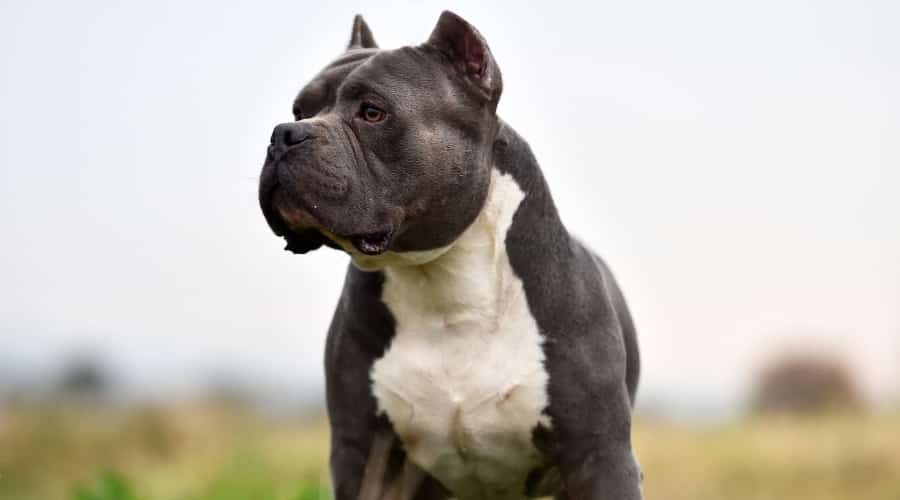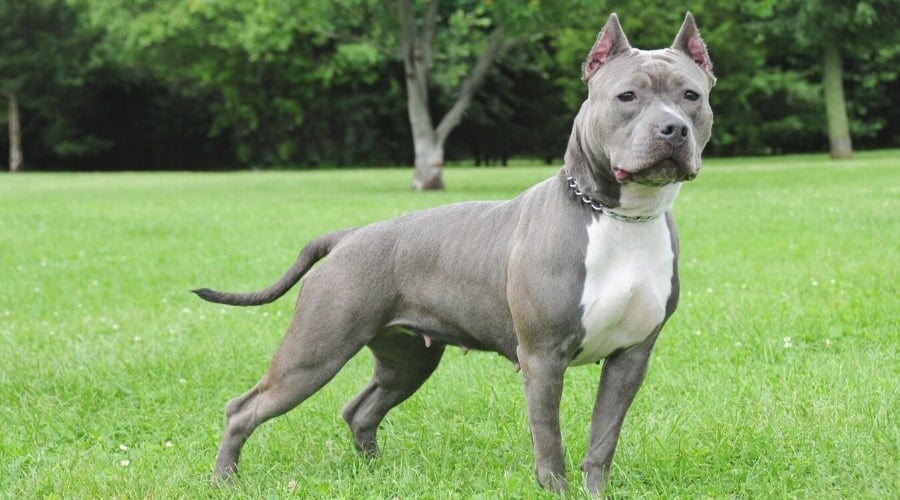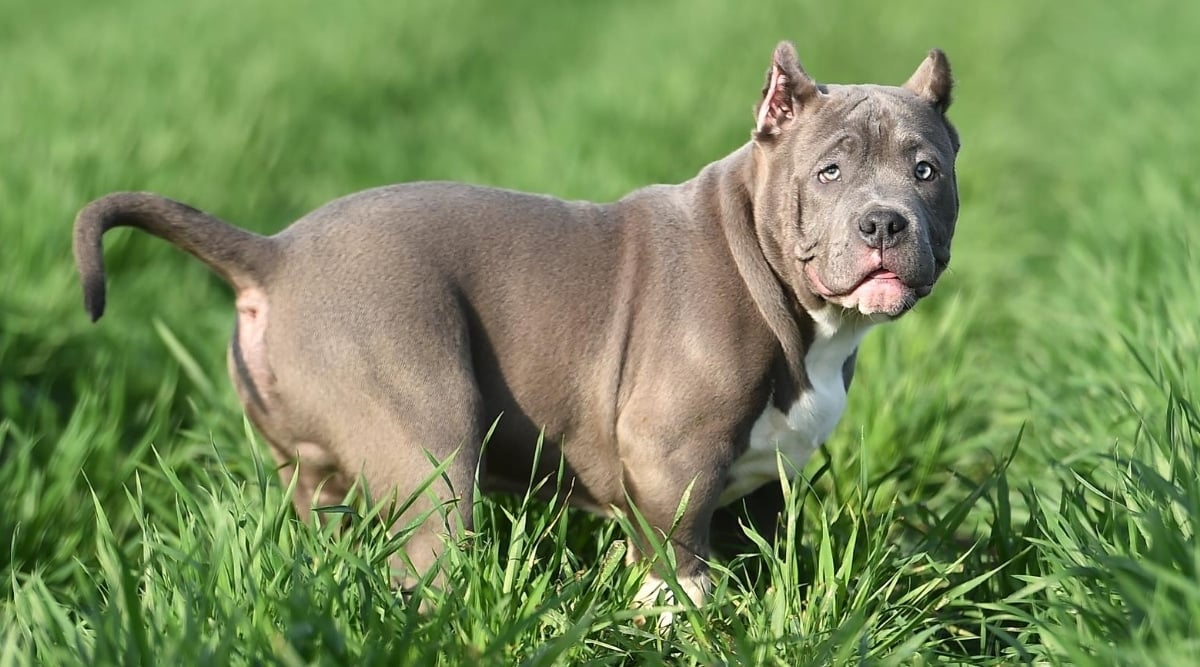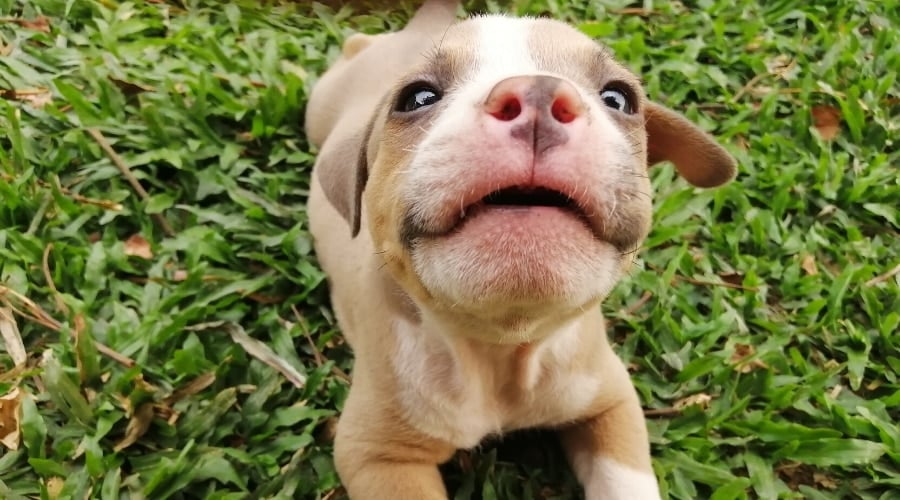American Bully Breed Information: Facts, Traits, Pictures & More
When you purchase through links on our site, we may earn a commission. Here’s how it works.
Are you considering adding an American Bully to your family? Let’s look at all the information you need to decide whether they are the right pet for you. From their fun, bold and loving nature to their intelligence and exercise requirements, we’ll cover it all and more.
American Bullies are intelligent and independent. They are affectionate, fun, and family-friendly. But they have quirks you should know before welcoming one into your home. Although they are beautiful dogs, they aren’t suitable for every family.
The breed is very similar to the American Pitbull Terrier, but they, in fact, are not Pitbulls. Their genetic cousins paved the way for them, but American Bullies have developed into a loving and unique breed of their own. Let’s learn whether this breed will be your next family companion.
Table of Contents
Breed History

The American Bully originated in the United States between 1980 and 1990. The American Bully is a mix of an American Bulldog, Pit Bull Terrier, and American Staffordshire Terrier. The American Bulldog and English Bulldog are also part of the genetic mix. The United Kennel Club recognized the American Bully breed on July 15, 2013.
Temperament
These doggies are affectionate and loving. They will be devoted and loyal to their families. They are very friendly and enjoy being around people. Despite their rugged exterior, these doggies are not natural protectors.
They are free-spirited and stubborn. This can make training somewhat cumbersome. However, enrolling them in a puppy kindergarten class early will help tremendously with obedience. Early socialization, such as exposure to different people, sights, sounds, and experiences, will help the puppy develop social skills. The more they are socialized, the better they will interact with people. This is important for a Bully since their robust appearance may cause people to be afraid of them.
Size And Appearance

According to the American Bully Kennel Club, four sizes exist, including Pocket, Standard, Classic, and XL. They can average from 13 to 23 inches in height and 25 to 120 pounds. Males can be 17 to 20 inches and females from 16 to 19 inches.
The American Bully has a wide and thick head with pronounced cheeks. Their muzzle is square and shorter than their skull.
Coat And Colors
The Bully has a straight, double coat. Their coats are smooth and soft. Generally, they come in all colors from Fawn, Solid Colors, Champagne, Chocolate, Brindle, Sable, Piebald, Red Nose, Blue Nose, Striped (Non-brindle), and Tri-Colored. Blue-nose or Red-nose refers to the color of the dog.
Bullies don’t shed too much and have coats that are easy to maintain. They are not dogs that shed their coats during the year, which keeps shedding considerably down. They need to be brushed once a week to keep their coats shiny and healthy.
Exercise Requirements

These doggies require daily exercise. They are high-energy dogs that love to run and play. They should be walked a minimum of 60 minutes a day. Be cautious letting them be off-leash as people often fear them, and seeing them loose may cause alarm. They should be walked on a leash when walking out in public.
If your American Bully is overweight, especially as their energy slows in the later year, talk to your vet about starting a weight loss formula.
Living Conditions
American Bullies can live in houses. They can also live in apartments as long as they are exercised every day. They require sixty minutes of daily exercise. If they are not exercised or have access to toys, they can get bored quickly, leading to destructive behavior, such as chewing and digging.
They can live with children and other pets as long as they have been exposed and trained to behave around them. Early socialization with exposure to smaller animals will help their interactions. Playtime with children and smaller animals should be monitored.
Training
Intelligent and independent, these pooches can be stubborn with training. This can make training difficult. It isn’t out of malice as these pups do not have a bad bone in their bodies. It is more so that they are energetic and want to play. Enrolling them in puppy training classes will start the training process. They will oblige with the chain of command if you’re firm, consistent, and patient.
Health

Your Elkhound may not develop any of these diseases. Still, it is crucial to be aware of them to maintain his health, especially if you consider the breed for your next companion.
- Progressive Retinal Atrophy (PRA): Progressive Retinal Atrophy (PRA) is a genetic disease degeneration of both rod and cone-type Photoreceptor Cells of the Retina degenerate leading to full or partial blindness. Unfortunately, American Bullies are likely to have this condition. There is no cure, but dogs can adapt well to vision loss. A genetic test can provide information on whether your pup is prone to PRA.
- Cherry Eye: This condition occurs when the gland under the third eyelid abnormally protrudes and looks like a cherry in the corner of the eye. This may happen in one or both eyes. The prolapsed gland will not be able to produce normal tears, resulting in chronic eye infections and a dry cornea.
- Hip Dysplasia: This is a condition where the cartilage and bone of the hip begin to wear down. Over time, this causes muscle atrophy, arthritis, and limited mobility. This can be painful and uncomfortable.
- Eczema: Eczema is a non-contagious skin condition. It is itchy and dry. There may be many causes, including allergies, hormonal problems, and hot weather.
Nutrition
Generally, a Bully can be fed 1 to 5 cups of high-quality dry food daily, depending on their age, size, activity level, and other factors. The range varies widely because of how wide-ranging the size of this breed can be (25 to 120 pounds)! Consult your food’s packaging and your vet to find the proper recommendations for your particular dog.
The feeding should be divided into two meals. Be cautious with table food and extra meals as they can become obese.
Grooming
The American Bully has a straight, smooth coat. They are average shedders who require brushing once or twice weekly to remove loose fur and keep their coats shiny. They can be bathed every eight weeks or as needed. However, don’t over-bathe this breed. When you bathe him, it’s recommended to use high-quality dog shampoo. Baths will help the dead and old coat fall out so new, healthy hair can grow.
Bullies can be prone to periodontal disease. Brush your Bully’s teeth at least two times a week to remove tartar buildup and the bacteria that lurk inside it. Daily brushing is even better for preventing gum disease and bad breath.
Nail and ear grooming are vital to the health of your Bully. Trim nails when they are about to touch the ground. For most dogs, this will be between 2-4 weeks. Take notice of odor or redness. it would be best if you trimmed your dog’s nails
Getting your Bully used to brushing and grooming when he’s a puppy will make grooming much more effortless. Play with his paws so he feels comfortable having his paws handled. Some dogs are fussy about having their paws touched, so the earlier you start getting them used to touching their paws, the better. Also, start looking inside his mouth and getting him accustomed to brushing and examination. You can make the experience fun and rewarding. Since they love food, giving them treats will help them associate grooming with a positive activity.
Breeders And Puppy Costs

A great place to start your breeder research is on the American Bully Kennel Club page and the American Bully Association of America. The average price for a puppy typically falls between $2,000 and $2,500. The price depends on several factors, including pedigree, lineage, breeder experience, proximity to the breeder, and mode of delivery. A pedigree Bully can cost around $2,000 and $10,000 on average.
Be wary of bargains or discounts. A lower price, in the beginning may mean higher costs in the future. Some breeders may not properly screen for medical conditions or socialize them enough.
As you prepare for your new puppy, also factor in the cost of supplies, food, toys, and medical expenses. Additionally, you may need to puppy-proof your home and yard.
Rescues And Shelters
Consider adoption if you want to make this loveable Bully your next doggy. These rescue organizations are a great place to get started on your adoption journey:
As Family Pets
American Bullies adore being with their family. He is known to be an exceptional family companion and great with children. They enjoy playing with them but are strong and can play rough. Playtime should constantly be monitored.
They are incredibly affectionate and eternally loyal. These gentle giants were specifically bred to be loving and gentle family dogs. These doggies love to play and enjoy fun activities. They love toys and need ones that will last their firm grip and pull.
Owners must also be firm with these intelligent pups. Although they are willing to please their owners, they are stubborn and will require consistent training. This doggy is best suited for a more experienced owner.
The American Bully can be a little skittish with other dogs and pets. Socialization with family pets at an early age will be beneficial in building these relationships.
Final Thoughts
The American Bully is a loving, intelligent and affectionate pup. He will make a loyal and devoted companion. This muscular beauty will require owners that will be firm yet loving. Owners must be attuned to their need for daily exercise and mental stimulation as with any pet, you are considering adding to your family.
Learning as much as possible about the breed and its needs is best. Bringing a doggy to your family is a long-term commitment. You will want to make the right decision for your family and the puppy.



